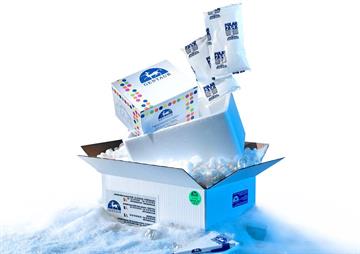Human SCF Recombinant Protein

Human SCF Recombinant Protein
449.62 EUR
In Stock
quantity
Produktdetaljer
Katalognummer: 209 - 100-097
Produktkategori: Företag och industri > Vetenskap och laboratorium
ReliaTechGentaur
Storlek: 10 µg
Related Products
100-097-SC
Human SCF Recombinant Protein
Stem cell factor (SCF), also known as c-kit ligand (KL), mast cell growth factor (MGF), and steel factor (SLF), is a widely expressed 28-40 kDa type I transmembrane glycoprotein. It promotes the survival, differentiation, and mobilization of multiple cell types including myeloid, erythroid, megakaryocytic, lymphoid, germ cell, and melanocyte progenitors. SCF is a primary growth and activation factor for mast cells and eosinophils. Mature mouse SCF consists of a 189 amino acids (aa) extracellular domain (ECD), a 23 aa transmembrane segment, and a 36 aa cytoplasmic tail. The ECD shows both N-linked and O-linked glycosylation. Proteolytic cleavage at two alternate sites in the extracellular juxtamembrane region releases a 25 kDa soluble molecule which is comparable to the only form produced by Steel-dickie mutant mice. An alternatively spliced isoform of mouse SCF lacks 28 aa that encompasses the primary proteolytic recognition site. Within the ECD of the short isoform (corresponding to this recombinant protein), mouse SCF shares 93% aa sequence identity with rat SCF and 72% to 75% with canine, feline, and human SCF. Rat SCF is active on mouse and human cells, but human SCF is only weakly active on mouse cells. Non-covalent dimers of transmembrane or soluble SCF interact with the receptor tyrosine kinase SCF R/c-kit to trigger receptor dimerization and signaling. SCF assists in the recovery of cardiac function following myocardial infarction by increasing the number of cardiomyocytes and vascular channels.
520.12 €
100-097S
Human SCF Recombinant Protein
Stem cell factor (SCF), also known as c-kit ligand (KL), mast cell growth factor (MGF), and steel factor (SLF), is a widely expressed 28-40 kDa type I transmembrane glycoprotein. It promotes the survival, differentiation, and mobilization of multiple cell types including myeloid, erythroid, megakaryocytic, lymphoid, germ cell, and melanocyte progenitors. SCF is a primary growth and activation factor for mast cells and eosinophils. Mature mouse SCF consists of a 189 amino acids (aa) extracellular domain (ECD), a 23 aa transmembrane segment, and a 36 aa cytoplasmic tail. The ECD shows both N-linked and O-linked glycosylation. Proteolytic cleavage at two alternate sites in the extracellular juxtamembrane region releases a 25 kDa soluble molecule which is comparable to the only form produced by Steel-dickie mutant mice. An alternatively spliced isoform of mouse SCF lacks 28 aa that encompasses the primary proteolytic recognition site. Within the ECD of the short isoform (corresponding to this recombinant protein), mouse SCF shares 93% aa sequence identity with rat SCF and 72% to 75% with canine, feline, and human SCF. Rat SCF is active on mouse and human cells, but human SCF is only weakly active on mouse cells. Non-covalent dimers of transmembrane or soluble SCF interact with the receptor tyrosine kinase SCF R/c-kit to trigger receptor dimerization and signaling. SCF assists in the recovery of cardiac function following myocardial infarction by increasing the number of cardiomyocytes and vascular channels.
370.88 €
400-013
Human SCF Recombinant Protein
Stem Cell Factor (SCF), a 18.4 kDa protein consisting of 164 amino acid residues (Asp26-Ala189) and fused to a C-terminal His-tag (6x His), is a hematopoietic growth factor that exerts its activity at the early stages of hematopoiesis. SCF stimulates the proliferation of myeloid, erythroid, and lymphoid progenitors in bone marrow cultures and has been shown to act synergistically with colony stimulating factors. This pleiotropic cytokine, alternately known as mast cell growth factor (MGF) and steel-factor (SLF), plays essential roles in gametogenesis, melanogenesis and early stages of hematopoiesis. In vitro and in vivo, SCF can stimulate the proliferation of mature, as well as the proliferation and maturation of immature, mast cells. On purified primitive human and mouse hematopoietic precursors, SCF acts in a synergistic manner with various growth factors, such as IL-1, IL-3, IL-6, IL-7, and Epo , to induce myeloid, erythroid and lymphoid lineage colony formation. The finding that SCF is also expressed in the nervous system suggests a possible role for SCF in the development of the nervous system. The cDNA sequences for human, mouse and rat SCF encode transmembrane proteins which are composed of a signal peptide, a 189 amino acid extracellular domain, a hydrophobic transmembrane domain and an intracellular domain. Native SCF can exist either as the membrane bound form or as a soluble form consisting of the first 164 or 165 amino acids of the extracellular domain. The soluble form is believed to be a proteolytic cleavage product of the transmembrane protein. Both the soluble and the transmembrane form of SCF have growth factor activities. Native soluble SCF is a heavily N- and O-glycosylated protein which exists as a non-covalently associated dimer in solution. All four cysteine residues of SCF monomers are involved in intramolecular disulfide bonds. Murine or rat soluble SCF is highly homologous to human soluble SCF (approximately 80%). Whereas both rat and mouse SCF are active on human cells, the human protein is much less active on mouse or rat cells.
433.88 €
Håll dig uppdaterad! Visa tidigare publikationer

By: Author , 2 Comment
Anaplasmos hos hundar och katter – allt du behöver veta
23 August 2025

By: Author , 2 Comment
Solbränna – hur leker man säkert i solen?
16 August 2025

By: Author , 2 Comment
Biologiska läkemedel – Modernitet inom farmaci
1 August 2025

By: Author , 2 Comment
Icke-steroida antiinflammatoriska läkemedel – viktig information om populära läkemedel
22 July 2025








